Madhya Pradesh
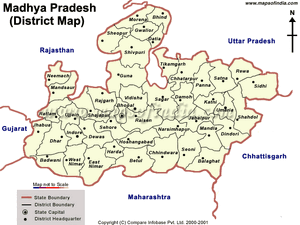

Madhya Pradesh (मध्य प्रदेश) is a state in central India. Its capital is Bhopal. It borders the states Uttar Pradesh, Chhattisgarh, Maharashtra, Gujarat and Rajasthan.The state straddles the Narmada River, which runs east and west between the Vindhya and Satpura ranges; these ranges and the Narmada are the traditional boundary between the north and south of India. As of 2024 Jats in Madhya Pradesh are around 32 lakhs
Districts and Tahsils in Madhya Pradesh
- Note - Click the links below to Districts and Tahsils to know more details
Jat gotras in Madhya Pradesh
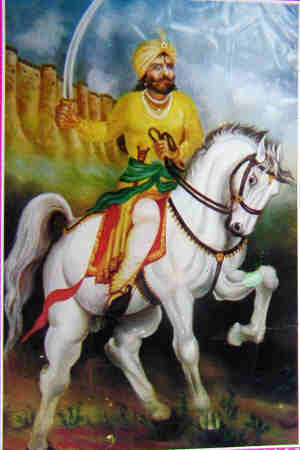
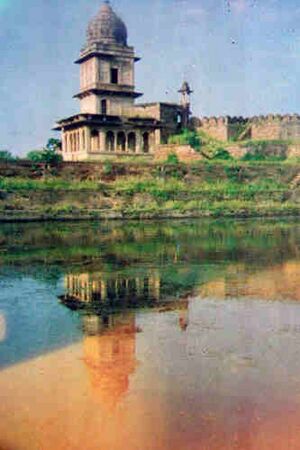
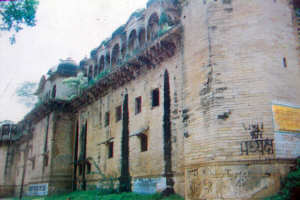
The early history
The earliest mention of Jats in Malwa region of Madhya Pradesh is by Thakur Deshraj in around 5th century BC. Thakur Deshraj has mentioned in his book on History of Jats “Jat Itihas” (Hindi) (1934) that the country Assyria gets its name from Asiagh gotra Jats. The origin of word Asiagh is from Sanskrit word ‘Asi’ meaning sword. According to Kautilya the people who depended on ‘Asi’ (sword) for their living were known as Asiagh. The Asiaghs moved from Asirgarh in Malwa to Europe. Those who settled in Jangladesh were called Asiagh and those who moved to Scandinavia were known as Asi. These Jats entered Scandinavia around 500 BCE. Another mention of Jats in Malwa of Madhya Pradesh by Thakur Deshraj is of dynasty of rulers the Singhvarma who was contemporary of Samudragupta (335-375 AD). Yasodharman was the king of Malwa, from the above dynasty, during the early part of the 6th century. The Gupta empire had been weakened by the attacks of the Indo-Hephthalites, known in India as the Hunas, towards the end of the 5th century, which caused it to break up into smaller states. Yasodharman declared independence. Yasodharman defeated a Huna army in 528, which checked the Huna expansion in India. Twin monolithic pillars at Sondani in Mandsaur District were erected by Yasodharman as a record of his victory.
[The above mentioned information is to be updated in view of the details available in the Risthal Inscription of Prakashadharman.the immediate predecessor and most likely father of Yashodharman.the inscription of the year 576(in most likelihood of Malava era)=515-16 A.D.tells us about six rulers of the Aulikara family to which we can add Yashodharman as the seventh.] Now we know that Yashodharman belonged to an illustrious Aulikara family about whose six rulers preceding Yashodharman the above said inscription informs us.This should demolish al theories previously popoundedby c. v.vaidya, Thakur Deshraj and others either identifying him with Vishnuvardhana of Bijayagarh inscription or connecting him with Singhvarma in any way]
Present Jat population
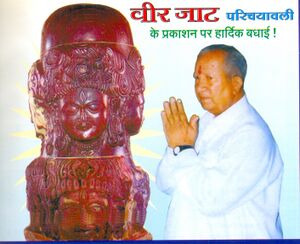
The population of Jats in Madhya Pradesh at present is not so significant to affect its policies but it has a sizable population in certain areas. The present Jats found in Madhya Pradesh trace their ancestors to have come from out side. They can be divided into four groups:
Jats migrated from Rajasthan
The lands in Rajasthan were unproductive and there used to be severe natural calamities at regular intervals. In addition to this the condition of Jat farmers were very miserable before independence in all respects socially, economically and politically. The jagirdars had imposed large number of cesses and lags on them. As such farmers were left with only about one fifth of its produce. They were badly exploited by jagirdars. Some people moved out of jagirdari areas to khalsa areas in Rajasthan itself, which were in direct control of the state. Others moved towards Madhya Pradesh. The scarcity of food and fodder for animals and the pressure of Jagirdars forced them to move out of Rajasthan. The Narmada River attracted them and they settled in Narsinghpur, Hoshangabad, Harda, Dewas, Indore and Dhar districts situated on the banks of Narmada. They hold good chunks of land in these areas. Their language and culture is malwi, which is very similar to Rajasthani. It appears that they carried with them the worship of Tejaji folk-deity from Rajasthan.
Jats migrated from Uttar Pradesh
The Jats of Uttar Pradesh who came to Madhya Pradesh were of three types (1) The freedom fighters of the first freedom movement of 1857 came to hide in the interior areas of Madhya Pradesh to avoid any punishments by British Raj. (2) Some people got jobs in the princely states or British governed areas like Hoshangabad, Sagar, and Narsinghpur etc. They got cheap lands and settled in these areas. (3) Some people left Uttar Pradesh due to their social or family or land disputes and settled in Madhya Pradesh. Some of them such as Bamraulias from village Bamrauli near Agra came in 1505 and founded Gohad Jat state. The Tomar Jats founded Bhind city and Khirwar Jats founded Narsinghpur city.
It is worth mentioning the importance of Gohad rulers who influenced the Indian History. Historically important rulers among above Jat rulers were Maharaja Bhim Singh Rana (1717-1756) and Maharaja Chhatra Singh Rana (1757-1785). They also occupied the Gwalior fort many times, Maharaja Bhim Singh Rana from 1740 to 1756, and Maharaja Chhatra Singh Rana from 1761-1767 and again from 1780 to 1783. During this period they constructed historical monuments in the Gwalior Fort -The Chhatri of Maharaja Bhim Singh and Bhimtal. Jat Samaj Kalyan Parishad Gwalior organizes Mela here on Ram Navami every year.
The Jat rulers of Gohad had constructed forts, palaces, temples, wells, gardens etc., which are of archeological importance and historical monuments. To mention some of them are Gohad Fort, Itayali Darwaja, Chhatra Mahal, Shish Mahal, Satbhanwar, Laxman-tal, Rani-guru temple, Laxman temple, Modi-ki-Haveli etc.
Jats migrated from Haryana
Jats from Haryana came mainly for cultivating lands here or to get jobs in industries or government organizations. Not many came for business from Haryana though many are engaged in dairy industry here.
Jats migrated from Punjab
The Jats of Punjab came to Madhya Pradesh mainly for business or to start industries. The transport and automobile industry has dominance of these people. The Punjab Jats came to Madhya Pradesh because conditions were favourable here as compared to Punjab.
Study of distribution of Jats in Madhya Pradesh
There is no study how these Jats spread to various areas in the state and the impact they left on the local people. According to Thakur Deshraj, the Malwa region gets its name from Mall or Malli republics who were famous during Mahabharata and Buddhist periods. Mall tribe is found in Jats and Brahmans. According to Katyayan they became Malwi in Brahmans and Mali in Jat Kshatriyas. Both these words have been derived from Sanskrit word Malav. Mall tribes were in the neighbourhood of Videhi tribe and came to this area in later periods. Earlier this country was known as Avanti. Vikramditya was ruler of this country. Malwa was a fertile and wealty country. Like Punjab and Sindh it was abode of Jats. Jats ruled this country.
I wanted to test the hypothesis put forward by Thakur Deshraj that the Mall tribe became Mali in Jats. From the following analysis I found that Mali Jats are there in Bhopal and Seoni malwa (Hoshangabad). Mali jats have also been found in analysis of Sikar Jat gotras. This indicates that when their republic was destroyed they moved to other areas of Madhya Pradesh and some moved to Rajasthan. Similar is the case with Siyak or Asiagh gotra mentioned by Thakur Deshraj. Siyak gotra is found in Seoni Malwa as well as in Bhopal. Siyak gotra is also found in Rajasthan.
Basis of Data analysed
I got gotra records from Smarika “Purusharth” published by Jat Sabha Bhopal “Pariwar Parichay Visheshank – 2003”. It has recorded gotras of 1091 members from all over the Madhya Pradesh state. The count of each gotra has been given in the following list in bracket after that gotra. It gives roughly the number of persons of that gotra per thousand in the state.
List of Jat gotras in Madhya Pradesh
1. adhran (1) 2. ading (1) 3. ahlawat (15) 4. anjane (1) 5. atri (8) 6. bagarwa (1) 7. baja (1) 8. balhara (1) 9. balyan (23) 10. bamal (1) 11. bamraulia (1) 12. bangadwa (4) 13. barach (1) 14. barad (1) 15. barayli (5) 16. bargoti (1) 17. basbana (1) 18. basman (1) 19. bast (2) 20. baswan (1) 21. batesar (4) 22. beda (16) 23. beniwal (1) 24. bhagor (2) 25. bhakal (3) 26. bhalothia (3) 27. bhamu (1) 28. Bharengar (10) 29. Bhari (7) 30. Bhukar (1) 31. Bijarnia (1) 32. bijolia (8) 33. binda (13) 34. bisayti (21) 35. bisonia (1) 36. bohra (12) 37. budhe (4) 38. budhwar (10) 39. burdak (4) 40. chahal (3) 41. Chahar (2) 42. Chandel (4) 43. Chaudhary (2) 44. chhokar (10) 45. Chikora (1) 46. Chotya (1) 47. Choyal (4) 48. Dabaria (1) 49. Dabas (1) 50. Dabisa (4) 51. Dadarwal (3) 52. dagar (8) 53. dahiya (3) 54. dalal (19) 55. dandak (12) 56. dashpuria (2) 57. dedar (4) 58. deshwal (9) 59. dhadaria (6) 60. dhainyar (1) 61. dhaka (5) 62. dhanerya (1) 63. dhankad (3) 64. dhankher (2) 65. dhatiriya (6) 66. dhayal (1) 67. dhillon (1) 68. dhorelia (1) 69. dilwal (3) 70. dingwal (4) 71. dinwal (2) 72. diswar (4) 73. dondaria (2) 74. dongre (1) 75. dudi (6) 76. durwas (1) 77. dusadh (4) 78. fadak (1) 79. faraswal (4) 80. fogat (11) 81. foyar (1) 82. gadarwal (1) 83. gahlawat (3) 84. garhwal (1) 85. gathware (12) 86. gehlod (1) 87. gehlot (4) 88. ghanghas (8) 89. ghariyala (1) 90. godara (4) 91. gode (1) 92. godha (1) 93. golia (4) 94. golya (3) 95. gora (1) 96. gulia (2) 97. guriwal (2) 98. hanselia (8) 99. hathingarwar (6) 100. hudda (4) 101. indolia (4) 102. jajda (1) 103. jakhar (4) 104. janawa (1) 105. jangoo (4) 106. jat (22) 107. jhunkale (1) 108. kadwal (1) 109. kadyan (11) 110. kajal (1) 111. kalhari (1) 112. kalkhanda (7) 113. kapdia (1) 114. karwada (2) 115. kashyap (3) 116. kaul (1) 117. khainwar (11) 118. khairwa (13) 119. kharb (8) 120. khatri (1) 121. khod (1) 122. khoja (1) 123. khokhar (7) 124. khutel (8) 125. kudia (6) 126. kuhad (1) 127. kuiya (5) 128. kulhar (1) 129. kundu (3) 130. lachau (1) 131. lakkad (6) 132. lalau (1) 133. lalgathwaria (4) 134. lamba (1) 135. lauchak (1) 136 legha(5) 137. mali (7) 138. malik(32) 139. mandia(4) 140. mann (2) 141. marawat (1) 142. maya (1) 143. mehria (3) 144. menchu (2) 145. mohla(1) 146. motra(1) 147. mudwara (1) 148. mundel (7) 149. naga (1) 150. nain (3) 151. nandav (1) 152. narolia (9) 153. narwar (2) 154. nauhwar (11) 155. naunwar (5) 156. nawad (1) 157. nehra (10) 158. nonwar (8) 159. ohlan (4) 160. pachar (9) 161. pachhare (4) 162. padode (3) 163. paldia (1) 164. palwar (24) 165. pander (4) 166. pandhal (9) 167. paraswan (1) 168. paraya (1) 169. patel (7) 170. pawar (2) 171. penda (1) 172. pichkya (3) 173. poras (1) 174. puchhwar (22) 175. punia (5) 176. rahi (1) 177. rajaura (7) 178. rana (7) 179. ranwa (5) 180. rao (1) 181. rathi (16) 182. rawat (3) 183. ruhil (1) 184. sangwan (24) 185. saran (29) 186. saroha (1) 187. serawat (1) 188. sheshma (3) 189. shyorat (4) 190. sidia (3) 191. sigar (1) 192. sihak (1) 193. sikarwar (5) 194. sindhu (4) 195. sinsinwar (8) 196. sirohi (30) 197. siwach (4) 198. siyak (6) 199. sogarwal (6) 200. sohrot (14) 201. solanki (12) 202. soni (1) 203. takhar (3) 204. tanwar (3) 205. tewatia (5) 206. thadwar (1) 207. thakur (5) 208. thakurel (9) 209. thakurela (6) 210. tharol (18) 211. thenua (29) 212. thukrele (4) 213. thusya (3) 214. tomar (13) 215. toor (3) 216. verma (3) 217. changal (2) 218. Jand (2) Total counts =1093
District wise distribution
The above data when compiled district wise we find the distribution of Jats in various districts as under:- Bhopal city (767), Rest of Bhopal district (79), Dewas (9), Dhar (5), Harda (35), Hoshangabad (9), Indore (23), Jabalpur (3), Khargone (3), Narsinghpur (7), Raisen (9), Rajgarh (11), Ratlam (1), Sehore (95), Shajapur (30), Tikamgarh (1), Ujjain (3), Vidisha (1) Total counts = 1091
Conclusions
- There are 216 gotras found in Madhya Pradesh.
- Maximum number of Jats was found in Bhopal. These are mostly engaged in various services, which have come from different states. Maximum variety of Jat gotras is also in Bhopal. The number of Jat gotras in Bhopal is 60. It appears that almost all people from Bhopal are members of Jat Sabha Bhopal. But Jat Sabha might not have accessed the interior areas for membership.
- Other areas in which Jats are found in sizable proportion are Bhopal district, Sehore district, Harda district, dewas district and Shajapur district. The Khategaon tehsil of Dewas district is very rich in Jat population which is not reflected in membership list. So I have added Dewas district by this observation.
- The list of gotras includes those of ladies also in many families. These gotras are few in number but provide variety to the gotras. In the list above Gotra with a single count normally indicates such Gotra. These are 78 gotras in the list.
- The larger fifteen gotras in decreasing order with counts are 1.malik (32) 2.sirohi (30) 3.thenua (29) 4.saran (29) 5.sangwan (24) 6. palwar (24) 7.balyan (23) 8. puchhwar (22) 9.bisayti (21) 10.dalal (19) 11.tharol (18) 12.rathi (16) 13.beda (16) 14.ahlawat (15) 15.sohrot (14)
- The Jats who became Zamindars in the state started using names like Thakur, Thakurel, Thakurele, Thakurela, Thukrele etc. All these combined are a sizable population making a count of 24 in the membership list.
- The Jats of Gwalior region put Rana as surname, which is based on a title.
- The Jat farmers of Malwa region use Patel as surname, which is used as a title for the headman of a village.
Regionwise distribution of Jats
Gwalior Region
Gwalior region is situated in north west Madhya Pradesh. The districts included in this region are Gwalior, Murena, Sheopur, Bhind, Datia, Shivpur and Guna. Gohad tehsil and part of Lahar tehsil in Bhind district; Murar block, Bhitarwar Block and Dabra tehsil of Gwalior district, Indragargh area of Datia district are consodered as a Jat belt. The Ranas of Gohad state are well known. The Jat rulers of Pichhore and Magrora were also very brave. There are 360 fortresses of Jat rulers and jagirdars in this Jat belt. Many of them are now in ruins. It is believed that there are many Jat families in this area who have huge amount of jwelry and gold.
The Sheopur tehsil of Sheopur district adjoining Rajasthan is also rich in jat population. There are many villages inhabited by Jats. About 40-45 villages around Sheopur are having Jats in majority. According to the records of Jagas and Bhats they had come to this area long back. It is believed that when Khilji was the ruler on Delhi, the Barauda area of Sheopur was ruled by Gond Rajas and the Jats of this area defeated Khilji. The oldest village of Jats here is Radep. This is inhabited by Kuradia and Mogar gotra Jats. Akodia gotra Jats were in the army of Maharaja Suraj Mal. After the death of Maharaja Jawahar Singh sardar Charandas Akodia came to Sheopur and settled here. He originally belonged to Ballabhgarh. He constructed a grand Laxman temple in Hasalpur, which is a unique example of architecture. He established his Jagir here. There are 8-9 villages of Akodia Jats at present out of these Talavra village is main. Other Jat gotras in the area are Mota, Punia, Rana (Ravna), Morya, Tagiya, Bhairovan, Dagar, Beniwal, Sinsinwar, Brahmanya and Dron. There was a Sikh Jat Jagir also in village Kailor whose last ruler was Hajari Singh. He was married in the family of Mursan rulers. Sheopur has a population of about 20000 jats. They are mainly doing cultivation. [1]
There life and culture is similar to that of Rajasthan. There are Jat Sikhs also in many villages of Sheopur kalan, jaganapura, jalalpur, dabra and barahet in bhind. The Jat Sikhs are of Gotras Gill, Dhillon, Pannu, Sidhu, Aulakh etc. Shivpuri and Guna have less population of Jats scattered through out.
Gwalior city has sizable population of Jats. There are about 1500 families in Gwalior city in Mill area. About 500 families are in Gwalior city. Most of them have come from Rajasthan, Haryana, Punjab, Delhi and Uttar Pradesh for service or business. [2]
Hoshangabad - Harda - Dewas region
Hoshangabad, Dewas and Harda districts has good population of Jats and they have good land holdings. They are scattered in Banapura, Seoni Malwa, Piparia areas. They have come from Rajasthan and Uttar Pradesh.

Joga Fort is an ancient fort built by Jats situated on the border of Dewas and Harda districts in Madhya Pradesh. It is located in the middle of Narmada River at a distance of 8 km from a small town called 'Bai Jog Bada'. It is a beautiful tourist spot full of natural beauty and biodiversity. [3]
This fort was built by two Jat warrior brothers Bhoga and Joga. They were contemporary of Alha and Udal warriors in the Army of Chandel rulers. Chandela rulers made them the governor of Nimar province where they ruled continuously till the rein of Mugals and Marathas. The great warrior Joga Singh Rao got constructed this fort. The elder brother Bhoga was killed in a war and Joga ascended to the throne. The folk tradition reveals that Joga loved one Gujar woman. It is believed that even after becoming the rani, the Gujari used to go by a secret route to take bath in the Narmada River and bring drinking water herself. There is a large population of Jats and Gujars surrounding the area. [4]
About 20 Kms down-stream of Nabhi point is Joga-ka-Quilla, an old strong rock fort in the middle of the river Narmada. Once upon a time this fort was used as a barrack to house armed forces. It has many special characteristics like inaccessibility to enemy and strategic location, beside strong exteriors. There are concealed deep wells, with water drawing facility. This fort was probably repaired by Hoshang Shah or Sultan Hushang Shah Gori. Hoshang Shah renamed Hoshangabad city in his own name which was earlier called Narmadapur after the river Narmada. Hoshang Shah was the second king of Mandu (Malwa) in early 15th century.[5]
The fort is still a site of unique beauty. The area surrounding the fort in a radius of about 25 km is good natural forest. It is situated on a 1000 metre high island above Narmada waters. It still reveals the history of Jat warriors even after 800 years have passed. [6]
Jabalpur region
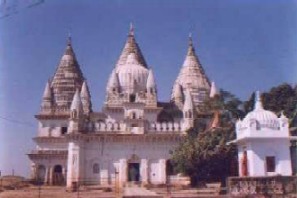
Narsinghpur area in the Jabalpur region has a good population of Jats and they are well off. They were the rulers in this area. There are many families of Jats in Jabalpur who are in service or doing business in Dairy. [7]
Narsinghpur has a large temple of Lord Narsingh known as Narsingh Avatar Temple . This temple was constructed by Jat Sardar in the 18th century. Khirwar clan Jats came to this place from Brij and founded the city of Narsinghpur, where they ruled for a long period. Khirwars of Narsinghpur were followers of god Narsingh. Here they constructed two temples of Narsingh avatar. And this temple has got its importance as district's Nomenclature hails from here only. [8]
Malwa region
The Jats in Malwa region are found in Ujjain, Dhar, Mandsaur, Nimach, Ratlam, Shajapur, Rajgarh, Dewas districts. They are dwelling in the rural areas of these districts. They are mainly dependent on agriculture. They follow the Rajasthani culture and language of about 500 years old. They worship Shiva, Rama, Lord Krishna, and Tejaji. Malwa people have great respect for out sider Jats and treat him as a god. [9]
Mandsaur and Neemach districts have a population of about 150000 Jats. Neemach town has about 250 families of Jats dwelling here. Mandsaur district has a rich Jat population in some villages. The Jats are classified in two categories here namely, Keje Jats and Meware Jats. They do not have marital relations with each other. In Mandsaur district there are about 78 villages with population of Keje Jats and rest are villages of Meware Jats. [10]
There are number of villages in Neemach after Jats e.g. Jat, Dayara, Luharia etc. Similarly Mandsaur also has villages after Jat gotras like Bailara, Muala etc.
The Malwa region is very important from the study of Jat History. Mandsaur and its neighborhood are full of archaeological interest. An inscription discovered near the town indicated the erection of a temple of the sun in 437, and at Sondani are two great monolith pillars recording a victory of Yasodharman, a Jat King of Malwa, in 528.[11]
The Gupta empire had been weakened by the attacks of the Indo-Hephthalites, known in India as the Hunas, towards the end of the 5th century, which caused it to break up into smaller states. Yasodharman defeated a Huna army in 528 and their ruler Mihirakula, which checked the Huna expansion in India. Twin monolithic pillars at Sondani in Mandsaur District were erected by Yasodharman as a record of his victory. [12][13]
Three inscriptions of Yasodharman have been found in Mandsaur. One of these is of samvat 589 (532 AD). Yasodharman had acquired the title of Vikramaditya. [14] He started the vikram samvat calendar of Hindus based on Lunar movements. The Kashmiri poet Kalhana has mentioned about three Kalidasas. The second Kalidasa, who wrote the books 'Raguvansha' and 'Jyotirvidabharan', was court poet of Yasodharman. Kalidasa has mentioned the victories of Yasodharman as 'Raghu-digvijaya'. His rule extended from Himalayas in the north to Travancore in south. The ruler of Magadha had become his friend. Chinese traveler Faxian visited India during his rule. [15] The victory of Yasodharman is mentioned in the sentence “Ajay Jarto Hunan” in the grammar of Chandra of the fifth century. This mention in the phrase sentence अजय जर्टो हुणान or “Ajay Jarto Huṇān”, refers to the defeat of Huns by the Jats under the leadership of Yasodharman. [16]
[[[Kalidasa's time can not be pshed down to the time of Yashodharman.He thrived duing the reign of Chandragupta-II Vikramaditya. Yashodhrman's father Prakashadharman gave a crushing defeat to the Huna king Tormana. We can't be sure which Aulikara of the two should e conected wih the statement 'ajayaj-jarto('t' is soft) hunaan' in the gramar of Chandragomin-if the text is authentic as eferred to.]
Famous Jats from Madhya Pradesh
Leaders
Ranas of Gohad
- Abhay Chander
- Bagh Raj
- Devi Singh
- Gaj Singh
- Jaswant Singh
- Maharaja Bhim Singh Rana
- Ram Chander
- Rana Ratan Singh
- Rana Shri Anup Singh
- Rana Uday Singh
- Sambhu Singh
- Singhandev II
- Udyaut Singh
Other fields
- Gurbaksh Singh Dhillon
- Satish Mandya
- Ganpat Singh Kunwar (Khainwar) - Social worker from village Amaliya Bheru (आमलिया भेरू) in Ratlam district in Madhya Pradesh.
Jat Politics in Madhya Pradesh
Jat MLA in Madhya Pradesh-2023
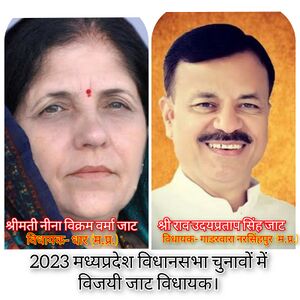
मध्यप्रदेश विधानसभा चुनाव में विजयी जाट विधायक।
1.श्रीमती नीना विक्रम वर्मा जाट (धार)
2. श्री राव उदयप्रताप सिंह जाट (गाडरवारा,नरसिंहपुर)
See also
- Ancient Places in Madhya Pradesh
- Gohad
- Malwa
- Narsinghpur
- Rivers in Madhya Pradesh
- Deogarh Chhindwara
- Madhya Pradesh Jat Sabha
External links
- https://villageinfo.in/madhya-pradesh.html
- https://en.wikipedia.org/wiki/List_of_Monuments_of_National_Importance_in_Madhya_Pradesh/East
- https://en.wikipedia.org/wiki/List_of_Monuments_of_National_Importance_in_Madhya_Pradesh/West
References
- ↑ Girraj Singh, Jat Veer, 1987-88
- ↑ Albel Singh Rana, JatVeer, 1987-88
- ↑ Chaudhary Raghuvir Singh: Joga Kila, Jat-Veer Smarika, Gwalior, 1987-88, pp. 49-50
- ↑ Chaudhary Raghuvir Singh: Joga Kila, Jat-Veer Smarika, Gwalior, 1987-88, pp. 49-50
- ↑ Hoshangabad District Government Website
- ↑ Chaudhary Raghuvir Singh: Joga Kila, Jat-Veer Smarika, Gwalior, 1987-88, pp. 49-50
- ↑ PCS Chandel JatVeer, 1987-88
- ↑ http://narsinghpur.nic.in/research.htm
- ↑ Kacharu Lal Olhan JatVeer, 1987-88
- ↑ Mohan Singh Jat Veer, 1987-88
- ↑ Mandasor Pillar Inscription of Yashodharman
- ↑ Fleet, John F. Corpus Inscriptionum Indicarum: Inscriptions of the Early Guptas. Vol. III. Calcutta: Government of India, Central Publications Branch, 1888, 147-148
- ↑ Mandasor Pillar Inscription of Yashodharman
- ↑ Kalhana: Rajatarangini
- ↑ Thakur Deshraj : Jat Itihas (Hindi), Maharaja Suraj Mal Smarak Shiksha Sansthan, Delhi, 1934, 2nd edition 1992 (Page 712)
- ↑ CV Vaidya, History of Medieval Hindu India
Further reading
- Smarika “Purusharth” published by Jat Sabha Bhopal “Pariwar Parichay Visheshank – 2003”.
- Smarika “Purusharth” published by Jat Sabha Bhopal, May 1985
- Girraj Singh: Jat Veer Smarika 1987-88, “Sheopur Kalan mein Jat Samaj”.
- Albel Singh Rana: Jat Veer Smarika 1987-88, “Gwalior mein Jat Samaj”.
- Kacharu Lal Olhan: JatVeer Smarika, 1987-88, “Malwa ke Jat”
- Mohan Singh: JatVeer Smarika 1987-88, “Jat samaj samiti Neemach”

